Last year, GeekDad Approved and Game of the Year finalist The Crew: The Quest for Planet Nine (read Jonathan’s review for more information) pulled off what I would have previously thought impossible, in making the inherently competitive trick-taking mechanic and structuring it into a cooperative game. This year, designer Thomas Sing has followed up on his award-winning creation with a stand-alone sequel that takes everything that was great about the first game and makes it even better.
What Is The Crew: Mission Deep Sea?
The Crew: MIssion Deep Sea is a game for 3-5 players, ages 10 and up, and takes about 20 minutes to play. It’s currently available at Amazon and your local game store. (Note that as an Amazon affiliate, I earn with qualifying purchases.)
The Crew: Mission Deep Sea was designed by Thomas Sing and published by Kosmos, with illustrations by Marco Armbruster.
The Crew: Mission Deep Sea Components

Inside the box, you’ll find:
- 40 large playing cards: 36 color cards and 4 submarine cards
- 5 large reminder cards
- 96 small task cards
- 5 sonar tokens
- 1 distress signal token
- 1 captain token
- 1 rulebook
- 1 logbook
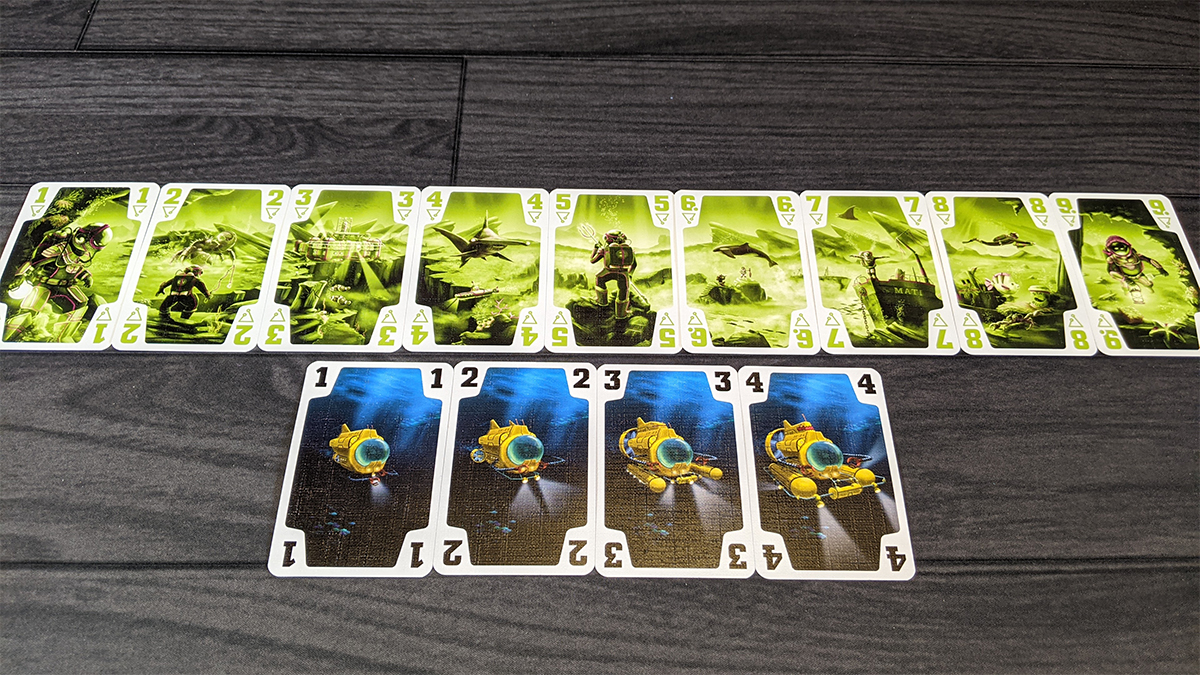
The color cards, submarines, and reminder cards are standard-sized playing cards with the same beautiful art by Marco Armbruster, who, just like in the first game, added a bunch of cute visual jokes to the game. The “1” card shows a diver with game designer Sing’s name, while the “8” card shows a can with a whale and the name “Starbuck.” As before, these touches don’t impact the gameplay, but these and other little easter eggs are fun to find.
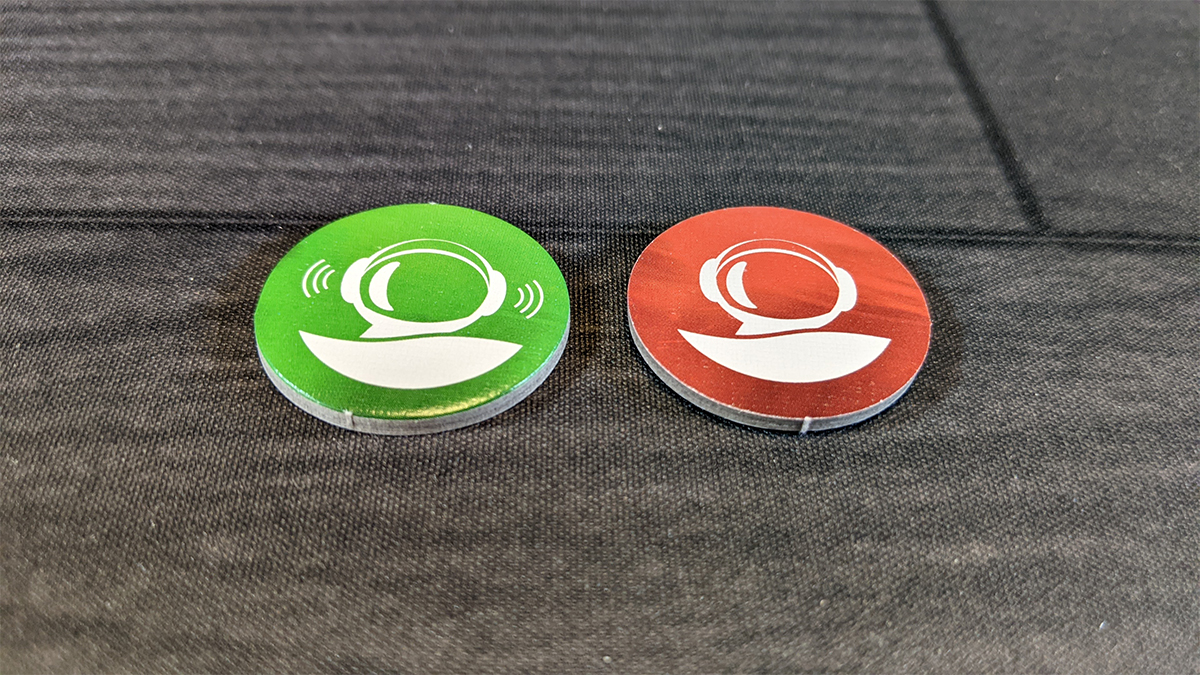
The cardboard components are nothing terribly exciting but serve their purpose well. There are the five “sonar” tokens for communicating with other players, the “distress signal” token, and the oversized “Captain” token for denoting the current first player.
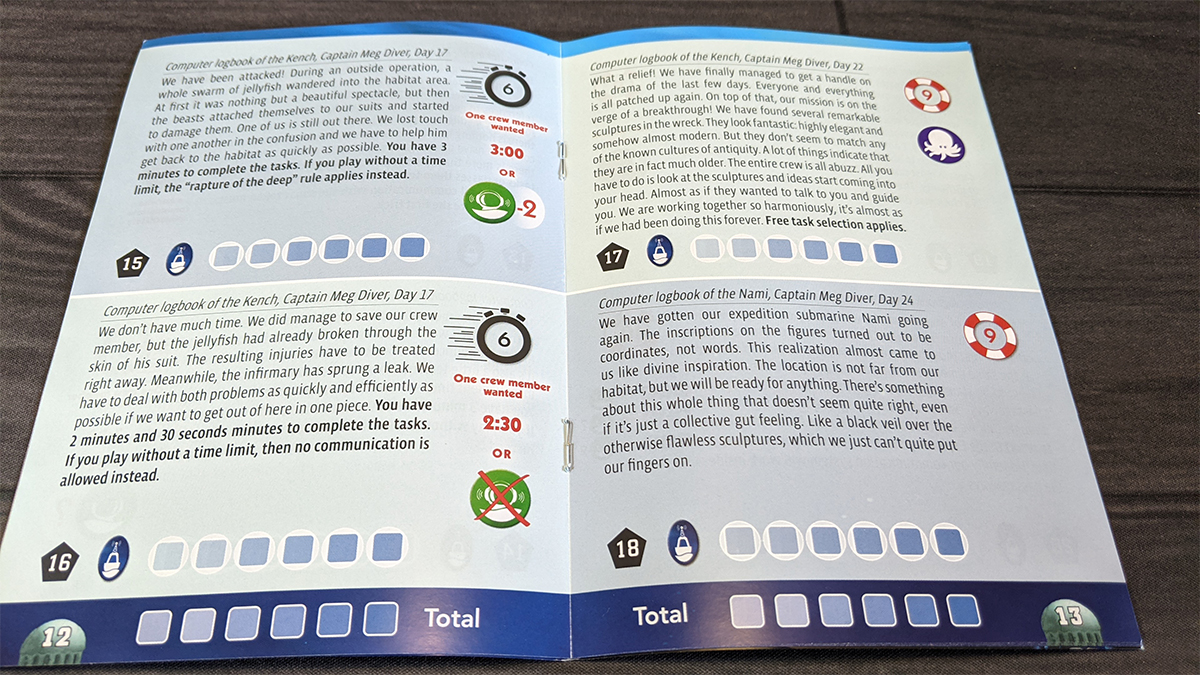
The rules and logbook are, as in the first game, divided into two separate books. The logbook details each mission the players will need to complete in the game, and provide a way to track how many times each mission took.
How to Play The Crew: Mission Deep Sea
You can download a copy of the rulebook here.
The Goal
The Crew is played over the course of 32 “missions”—you can play them in order and use the logbook to keep track of the number of attempts it takes you to complete the entire journey, or you can simply skip around and play individual missions as desired. The goal of each mission is to complete a certain number of tasks, which are drawn from the tasks deck.
Setup
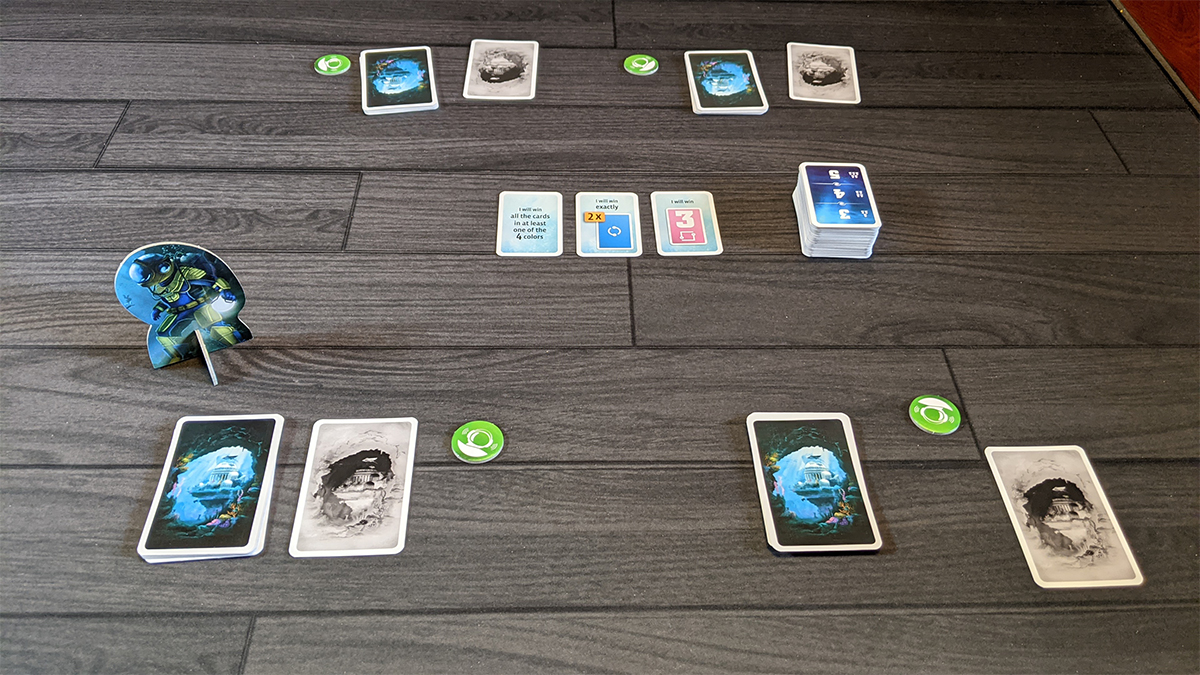
Shuffle the color cards and the submarine cards together, and deal out all the cards to the players. (In a 3-player game, one person will get one extra card, which will not be played.) Give each player a sonar communication token, placed green-side-up. The player who was dealt the “4” submarine takes the captain token. Set the reminder cards to the side, as well as the distress signal token, face-down.
Shuffle the task cards and place them in a face-down deck.
Gameplay
To begin a mission, look it up in the logbook. Each mission indicates a mission difficulty. Each task card has three degrees of difficulty printed on the back: one for three players, another for four, and another for five. Based on this, you draw cards from the task deck to exactly match the degree of difficulty specified in the logbook for the mission. Cards that would add up to more than the difficulty are simply skipped and placed back on the deck to be used in future missions. The number of cards drawn for missions is therefore somewhat luck-based: for example, a task with a difficulty of 5 might need only one card, or might need as many as five.
The rules “suggest” that used task cards not be shuffled back into the deck right away, to minimize the number of times each task comes up. We have yet to play a session where we came close to running out of cards, but if you do, you can simply reshuffle the deck.
Once the task cards are selected, they should be flipped over face-up and laid out in a row. Then, the captain selects the task they believe they can most easily complete. If there is more than one, players go in clockwise order, each selecting a task. It’s possible some players won’t get tasks, and it’s possible some may get more than one.
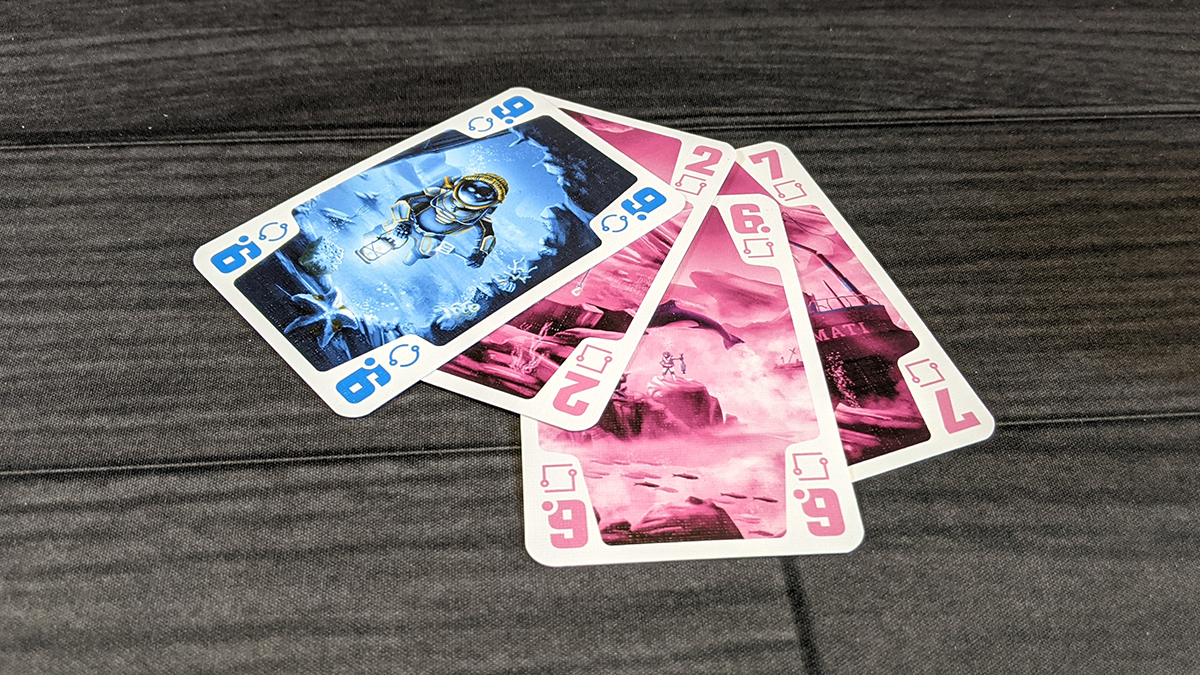
Each mission begins with the captain playing a card from their hand. Then, the rest of the players take turns playing cards from their hands. But as with any trick-taking game, players must follow suit if they can. This means that if the captain plays a blue card, everyone else has to play a blue card as well—even if they don’t want to. But, if they are out of the color that was led, they are allowed to play any card they wish from their hand. Once everyone has played, whoever played the highest value card (the cards are all numbered from 1 through 9) takes the trick (meaning they pick up all of the cards and place them to the side). That player then leads the next trick by playing any card they wish from their hand.
The four submarine cards are the trumps. These can be played any time someone cannot follow suit, but they automatically take the trick, regardless of their value, so the 1 submarine card can take a trick even if the 9 of the lead suit had been played. If more than one submarine is played, the highest of them (they are numbered 1-4) wins. It is legal to lead a submarine, in which case, anyone with a submarine must play it, and anyone else can play whatever they want.
Note that as with any trick-taking game, a player who does not follow suit can never win the trick, unless they play a submarine card.

One of the real twists in the game—and what makes it a really great game—is that players may not, ever, discuss the contents of their hands. Instead, once per round, they may communicate something using the sonar token. But, they are limited in what they can communicate. They are allowed the place one card face up in front of them and place the sonar token on it. If they place it on the top of the card (furthest away from them), they are saying that the placed card is the highest card they have in that suit. If they place the token closest to them, they are saying that card is the lowest that they have in that suit. And if they place the token in the center of the card, they are saying that it is the only card they have in the suit. When you do communicate, you take one of the reminder cards into your hand as a reminder that you have a card laying on the table that you can still play at some point.
However, those three attributes—highest, lowest, and only—are the only things they are allowed to communicate. So if they know that a partner needs to take the 7 of a suit, and they have it, they can’t communicate that fact unless it fits one of those criteria. If they have the 8 or 9, and any cards lower than 7, then there’s simply nothing they can do.
It’s worth noting that these aren’t the only limitations to communication. They are merely the limits on using the sonar token. Sometimes, not communicating anything is communication. And also, playing a card offsuit tells everyone else that you are out of a particular suit, which savvy players can use to their advantage.

Once per mission, players may collectively decide to use the distress token. This has to be done once all of the cards are dealt and the tasks chosen, but before a card is played or anyone has communicated anything. If players agree that they might need a little extra help, they can flip the distress token over, showing it’s been used, and then, every crew member will pass one card from their hand to their neighbor. The group decides whether to pass left or right, but everyone has to pass in the same direction. Submarine cards cannot be passed. This can be used to make impossible tasks possible, or maybe just to make things a bit easier—it is, for example, generally easier to take a card you don’t have in your hand. If you’re recording plays in the logbook, you are supposed to circle the distress symbol there, and increase the number of attempts by one as a “penalty.” Note that the signal can only be used once per mission, meaning that if you use it and still fail the mission, you cannot use it again until you find a way to complete the mission.
Missions end as soon as all of the tasks are complete or as soon as any one of the tasks becomes impossible to complete (most often, because the wrong person won a trick).
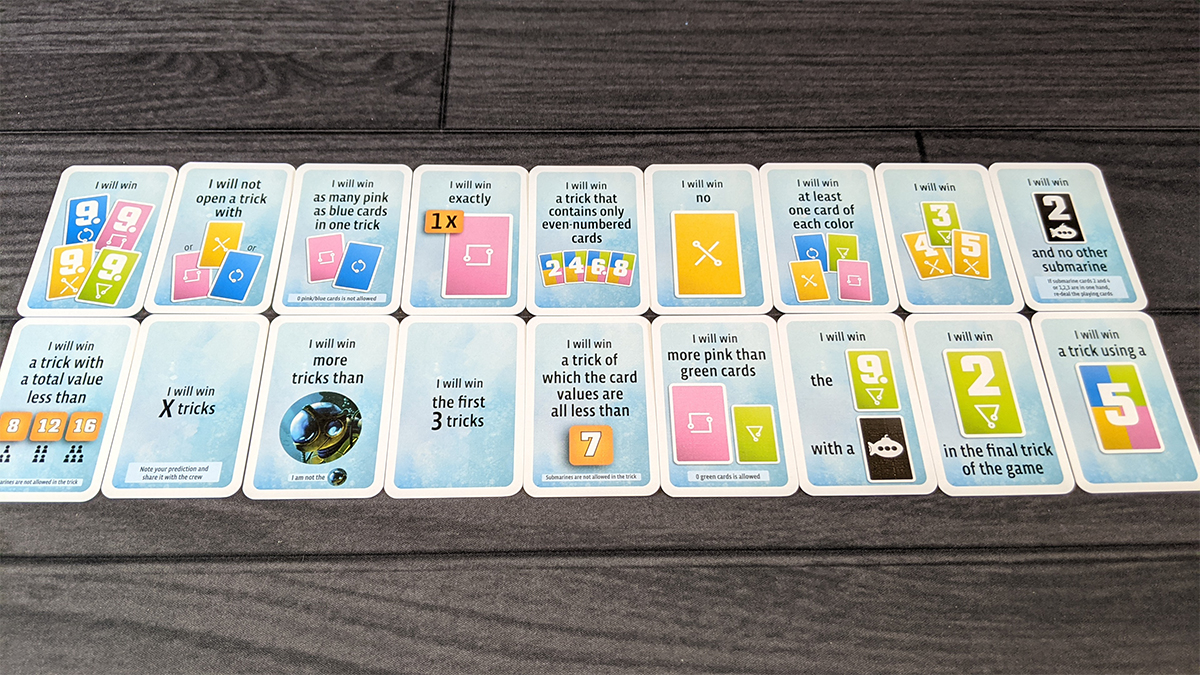
The biggest change from the original game is in how the tasks work. In the first game, all of the tasks involve a particular player taking a trick that contains a particular card. There are some variations in the order in which these have to be taken and whatnot, but basically, it all revolves around making sure someone takes a specific card. In this game, the tasks are much, much more varied. There are still some that say that the player who takes the task has to win a particular card, but most of the tasks are more complicated. For instance, there’s a task that says that the player will take a trick made up of nothing but even cards. There’s one where the player cannot win any of the first five tricks, or one where they must win the first two tricks. There’s one that reads, “I will win exactly 2 tricks and they will be in a row.” There are tasks where a player has to win a trick by using a particular card, or tasks where the sum of the cards played in the trick have to be over a certain value.
This new approach to tasks makes the game much more varied and ultimately more difficult. It’s even possible to be in a situation where the mission is impossible to complete from the very start. In one game we played, there were two tasks that needed to be completed. My daughter was the captain and, because she didn’t know what I had in my hand, she left me to take a task saying that I would take a trick using a 3. The problem? I didn’t have any 3s in my hand. So, we just lost that mission without playing a single card.
While many of the tasks mean that the group may complete a mission without playing out the entire hand—something that is relatively common in the original game—many of the new tasks require playing every card. You cannot, for instance, know that you are only going to take exactly 2 tricks until they have all been played.
2-Player Variant
Even though the box says the minimum is three players, the rules do include a two-player variant.
For 2 players, during setup, you set the 4 submarine aside. Then you place 7 face-down cards in a row, with 7 face-up cards on top of them. Finally, shuffle the 4 submarine back into the deck and deal the rest out to the players.
The captain, in addition to starting the task selection and the first trick, is also responsible for Tonoja, the AI system represented by the 14 cards. When it is Tonoja’s turn, the captain selects a face-up card to play. Once a face-up card has been played (and the trick is finished), the face-down card below it is revealed and can be played on future turns.
Game End
The logbook contains a set of boxes for each mission so that players can mark off when they complete a mission. In theory, a game of The Crew involves playing through all of the missions in the fewest number of tries possible.
In practice, though, a game consists of playing through missions until you mutually decide you’re done for this session. I don’t know exactly how long it would take to play through all 32 missions in a single sitting, but it’d be a while. We’ve never done it, and would much rather just play a dozen or so hands—whether that means completing four missions or ten—and keep the game fresh. When we play with a set group, we try to remember which mission we were on when we stopped and pick up from there, but the reality is that the missions are so varied here that every hand is going to be totally different, even if you just played the same missions over and over.
The Crew: Mission Deep Sea is GeekDad Approved!
Why You Should Play The Crew: Mission Deep Sea
As you might be able to tell, I’m a big fan of The Crew: The Quest for Planet Nine. I first played it online when we were determining our Game of the Year in 2020, and while it ultimately didn’t win, it very quickly became one of my favorite games of last year. I don’t remember if I ordered myself a copy while we were still playing or waited until we were done, but I knew I wanted the game on my shelf right away. I got my parents a copy for Christmas, and it’s become the game that they played this year more than any other.
Sequels, as we all know, are tricky. How do you retain the magic of the original while also coming up with ways to keep things fresh? It’s hard, but Thomas Sing has nailed it here. This is more The Empire Strikes Back or The Godfather II—a sequel that fully lives up to, and in many ways, surpasses the original.
The key, of course, was in rethinking how the missions work. I enjoy the challenge of trying to make sure a particular player takes a particular card, but trying to ensure that I can a set number of tricks is even more of a mental challenge. Trying to make sure that you not only take a card but that you use it to win the trick is another level of challenge.
The original The Crew ensured replayability by having the card that needs to be taken be drawn randomly from a deck. But Mission Deep Sea again surpasses that. Even the very first mission, where you simply need to complete a single task with a difficulty of one, can be a totally different experience if you have a task that requires you to take a particular card versus the task where you have to take two tricks in a row.
By increasing the variability and the challenge, Sing has taken what was already a brilliant concept and made it even better. I might not have guessed that was possible, but it was. Fans of the original The Crew will certainly love this game, but those that haven’t played the first game are sure to love diving right into Sing’s world with this game.
The Crew: Mission Deep Sea is GeekDad Approved, and you can (and definitely should) get your copy today.
Click here to see all our tabletop game reviews.
![]() To subscribe to GeekDad’s tabletop gaming coverage, please copy this link and add it to your RSS reader.
To subscribe to GeekDad’s tabletop gaming coverage, please copy this link and add it to your RSS reader.
Disclosure: GeekDad received a copy of this game for review purposes.






